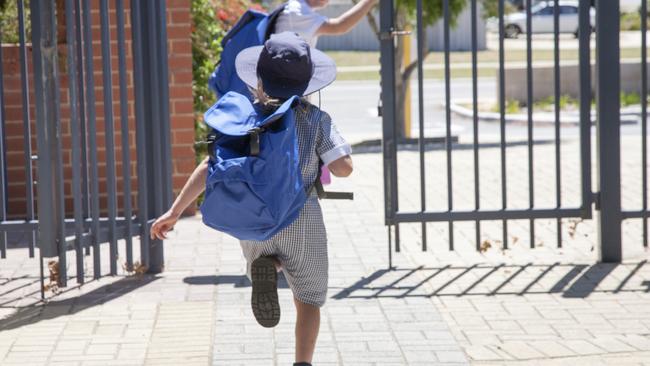Revealed: Rural schools suffer shocking student decline
Timber and irrigation towns have seen their school numbers slashed after falling victim to inner city voters’ demands. See the changes in enrolment numbers at every country school in Australia.

Rural and regional schools are falling victim to inner city voters’ demands to end native forest logging and strip irrigation towns of water for the environment.
Analysis of Australian Curriculum, Assessment and Reporting Authority enrolment data shows 50 Victorian, NSW and South Australian irrigation towns have lost an average 28 per cent of their students since federal government water buyouts began in 2008.
Fourteen years ago 15,162 students walked through the front gates of those 50 irrigation towns’ schools, but just 10,974 did the same last year.
The slump comes despite statewide enrolments rising by 14 per cent across regional Victoria since 2008, while NSW and South Australia country student numbers remained stable.
Forest lockups, environmentalists’ legal action and tightening government regulations have also triggered successive waves of cutbacks to logging quotas in Victoria, driving working families out of timber towns, such as Orbost, Heyfield, Cann River, Omeo and Swifts’ Creek.
Enrolments across Orbost’s secondary college and three primary schools have slumped from 582 in 2008 to just 390 last year, forcing the town to amalgamate three of the schools into a P-12 Community College from next year.
College principal Peter Seal said the timber industry job losses was “one of the main reasons” for the slump in enrolments.
East Gippsland forestry consultant and Orbost chamber of commerce member Garry Squires said it was “death by a thousand cuts”, as workers left town and student numbers plummeted.
But Mr Squires warned the impacts of the Victorian government’s latest decision, to phase out all native forest logging from January 1, would take two or more years to flow through to the community.
Orbost harvest and haulage contractor Rob Brunt said the town had gone from 21 harvest contractors – employing about 100 bush workers and 40 truck drivers – down to three contractors today who had no work.
In 2017-18, when the Andrews government halved Heyfield’s ASH timber mill’s quota, 100 jobs were lost, with local primary school enrolments dropping from 197 in 2018 to 110 in 2022.
Swifts Creek P-12 school principal Robert Boucher said the town’s timber mill was still operating, sourcing logs from NSW, but “we know there’s a dark cloud sitting above us at the moment”, with enrolments slipping from 102 last year to 90 in the new year.
NSW forestry communities face just as much uncertainty, with state Greens MP Sue Higginson saying last week “the end of native forest logging is close and inevitable”, with logging in the Myrtle, Braemar and Newry State Forests subject to court proceedings.
Out in the Murray Darling Basin small irrigation towns are also being stripped of water, wealth, workers and children.
Eighty per cent of the 2100 gigalitres pulled out of irrigation districts to date has come from southern MDBA communities, with two-thirds of that recovered through buyouts initiated by the former Rudd-Gillard Labor government in 2008.
The impacts can be seen in the Goulburn, Murray, Murrumbidgee, Sunraysia and Riverland, with schools such as Kerang Technical College’s enrolments crashing from 494 in 2008 to 243 last year.
The loss of water has bled the dairy industry dry, crippling towns like Leitchville and Rochester, whose dairy factories closed down, leading to major job losses that have crushed primary school enrolments.
Leitchville primary school student numbers have fallen 70 per cent, from 44 in 2008 to 13 last year, while Rochester primary’s enrolments fell 40 per cent, from 296 to 177 over the same period.
Some schools in larger towns, with a greater diversity of industries are doing better, often thanks to the efforts of dedicated teachers and vibrant principals.
Cobram Secondary College principal Kimberley Tempest has just taken out Victoria’s most outstanding principal award for her efforts to revive the school’s culture and numbers.
ACARA data shows the Cobram College’s enrolments had slumped from 599 in 2008 to 384 in 2022.
Ms Tempest said enrolments had dropped to a low of 320 in 2018, which she had managed to turn around since taking on the top job six years ago, with the adoption of a more positive school culture and facility upgrades.
But Victorian Farmers Federation water council chair and Murrabit dairy farmer Andrew Leahy said decreasing enrolments could put schools into a cycle of decline, which he had seen at Kerang Secondary College.
“There’s about 200 left, so I’ve sent my kids to boarding school in Ballarat, otherwise I’d have to drive them an hour each way to Echuca,” Mr Leahy said.
He said the loss of water had devastated dairying in northern Victoria, with Dairy Australia figures showing production has declined from two billion litres in 2008 to just 1.48 billion in 2022.
“We’ve gone from 28 dairy farmers in the (Murrabit) district down to four,” Mr Leahy said.
But the situation is about to get far worse as the Albanese federal government rams legislation through Parliament, allowing it to buyout even more.
Read related topics:Murray-Darling Basin Plan




